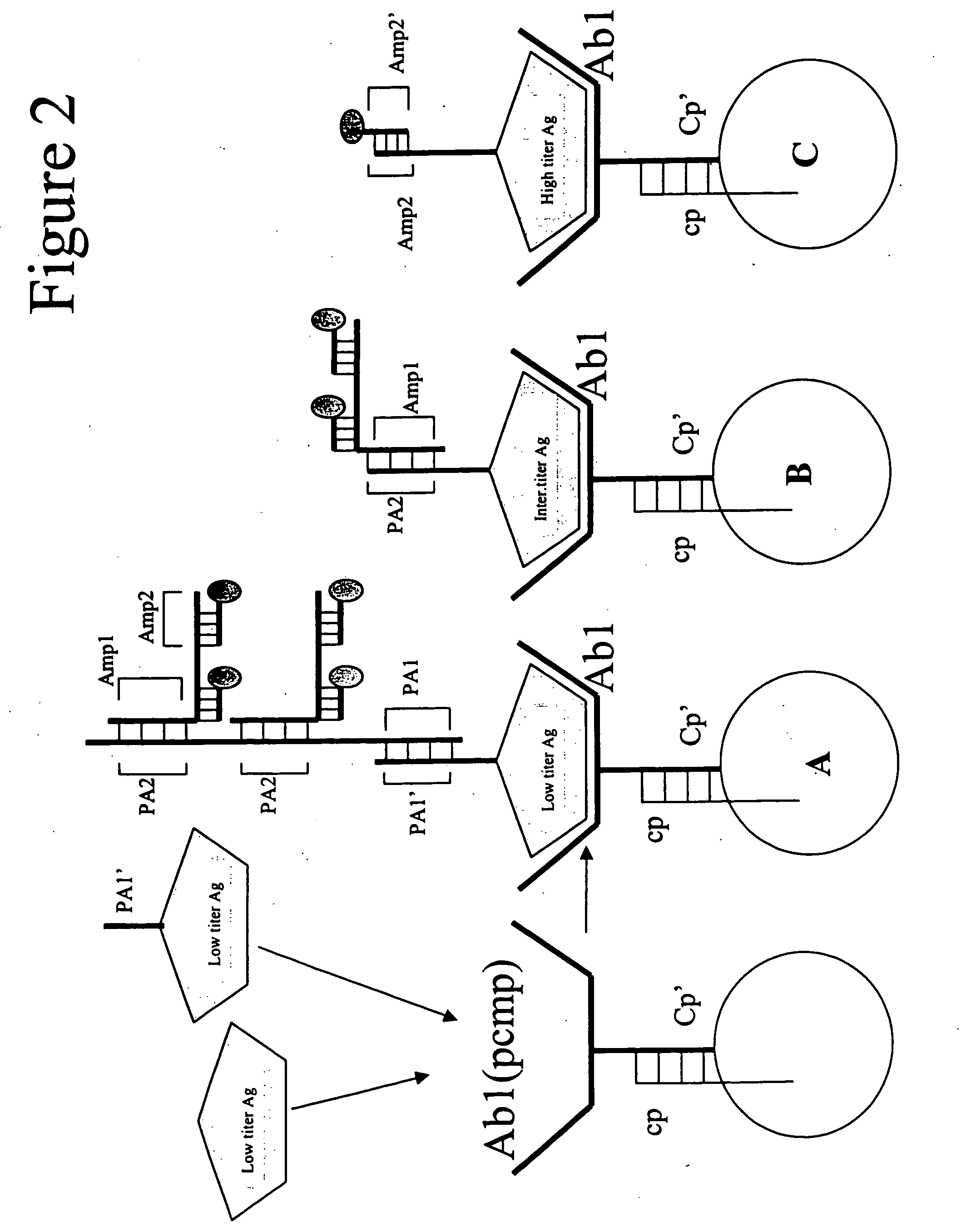Three dimensional apparatus and method for integrating sample preparation and multiplex assays
a three-dimensional apparatus and multiplex technology, applied in the field of multi-systems, can solve the problems of multiplex analysis, array is not suitable, and is unsuitable for the present invention
- Summary
- Abstract
- Description
- Claims
- Application Information
AI Technical Summary
Benefits of technology
Problems solved by technology
Method used
Image
Examples
example i
[0089] This example explains how to design universal sequences for the assay. First one generates sequences for signal amplification; then one generates capture probe and capture mediator sequences. One generates sequences randomly by computer having a certain range of Tm values. One then selects sequences with the following characteristics: negligible secondary structure for efficient hybridization and limited runs of purines or pyrimidines, and sometimes a fixed length. The Tm of PNA-DNA hybrids was calculated with the following empirically determined coefficients in table I.
TABLE INumberCoefficientDelta Hdelta S1AA−8.4−22.52AC−8.6−21.63AG−6.1−14.34AT−6.5−16.35CA−8.6−22.16CC−6.7−15.87CG−10.1−25.98CT−6.1−15.19GA−7.7−18.010GC−11.1−28.411GG−6.7−13.012GT−8.6−21.313TA−6.3−19.214TC−7.7−21.215TG−8.6−22.716TT−8.4−23.817Lys−0.25−1.418Initiation0−5.9
[0090] The first 16 entries are the base-stacking enthalpies in Kcal / mole and the base-stacking entropies in entropy units. The entries in ro...
example 2
[0101] This example explains how to select targets and how to design target-specific mediator probes. The first decision is always the appropriate choice of the target molecules for the multiplex panel under consideration. The best markers to be used to detect and stage disease and assess response to therapy are in a rapid state of flux due to the explosion of information from genomics and proteomics. Some analyses must be done by immunoassay and some must be done by probe assay. However, many analytes can be detected by either method. In this case, one must first decide between immuno-markers and nucleic acid sequence markers. The choice will depend on the titer of the different targets, the availability of suitable antibodies, the availability of nucleic acid sequence information. In some cases, both antigens and nucleic acid markers will be used. This is useful for confirming positives.
[0102] For immuno-markers, antibodies are selected by methods well-known in the art for their ...
example 3
[0119] In one method of using the invention, cmps and pcmps are preloaded into various zones in the column using the appropriate universal sequences and channeling the cmps directly from section B to section C without passing through zone 21. (Alternatively, cmps are mixed with sample and sample buffer). In preparing the sample, sample preparation buffer may contain in addition to cmps, labeled competitor antigens, PA and lmps. Alternatively, (except for the labeled competitor antigens) the PA and lmps may be directed through the column after sample has been processed through the column as previously discussed.
[0120] The samples are denatured with detergents and specific enzymes (e.g., bead-immobilized enzymes). The sample mixture is then passed over the column with the immobilized enzymes and denaturants being removed as the sample mixture passes through section A. The sample preparation for antigen targets is completed in section A, optimally by re-circulation. After completing s...
PUM
| Property | Measurement | Unit |
|---|---|---|
| volumes | aaaaa | aaaaa |
| volume | aaaaa | aaaaa |
| volume | aaaaa | aaaaa |
Abstract
Description
Claims
Application Information
 Login to View More
Login to View More - R&D
- Intellectual Property
- Life Sciences
- Materials
- Tech Scout
- Unparalleled Data Quality
- Higher Quality Content
- 60% Fewer Hallucinations
Browse by: Latest US Patents, China's latest patents, Technical Efficacy Thesaurus, Application Domain, Technology Topic, Popular Technical Reports.
© 2025 PatSnap. All rights reserved.Legal|Privacy policy|Modern Slavery Act Transparency Statement|Sitemap|About US| Contact US: help@patsnap.com



